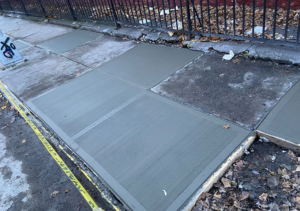
Queens, New York, known for its vibrant neighborhoods and diverse communities, boasts a vast network of sidewalks that serve as essential pathways for its residents and visitors. These sidewalks, while often taken for granted, play a crucial role in ensuring safety and accessibility for all. However, like any infrastructure, they require regular maintenance and repair to remain in optimal condition. We will explore the significance of sidewalk repair Queens, the common issues faced, the repair process, and the importance of timely intervention.
The Significance of Sidewalks
Sidewalks are an integral part of urban life, providing safe and convenient routes for pedestrians. In Queens, these concrete walkways serve as the arteries of the city, connecting homes, businesses, schools, and parks. Sidewalks offer numerous benefits:
Safe Passage
Sidewalks provide a designated space for pedestrians, separating them from vehicular traffic, which significantly reduces the risk of accidents and injuries. This safety element is especially critical for children, the elderly, and individuals with disabilities.
Accessibility
Sidewalks are essential for ensuring that everyone, regardless of physical abilities, can navigate the city independently. Properly maintained sidewalks with curb cuts and ramps enable wheelchair users and those with mobility challenges to move freely.
Environmental Benefits
Sidewalks encourage walking, which promotes a healthier lifestyle and reduces the reliance on cars. This reduction in vehicular traffic has positive environmental impacts, including lower emissions and improved air quality.
Common Sidewalk Issues
Despite their importance, sidewalks in Queens face various challenges that can hinder their functionality and safety. Some of the most common issues include:
Cracks and Tripping Hazards
Over time, sidewalks can develop cracks and uneven surfaces due to factors like weather, tree roots, and wear and tear. These imperfections can pose tripping hazards, leading to injuries and lawsuits.
Tree Root Damage
Queens’ tree-lined streets are beautiful, but tree roots often extend beneath sidewalks, causing them to lift and crack. While trees are a valuable part of the urban landscape, their roots can be a constant source of sidewalk damage.
Wear and Tear
Heavy foot traffic and exposure to the elements can lead to general wear and tear on sidewalks. This includes surface erosion, crumbling edges, and overall deterioration.
Lack of Accessibility Features
Outdated or poorly maintained sidewalks may lack necessary accessibility features, such as ramps and tactile warning strips. This can limit the mobility of individuals with disabilities.
The Sidewalk Repair Process
When it comes to Queens sidewalk repair, a systematic approach is crucial to address these issues effectively. Here is an overview of the typical sidewalk repair process:
Inspection and Assessment
The first step in any sidewalk repair project is a thorough inspection and assessment. Trained professionals evaluate the condition of the sidewalk, identifying areas that require repair or replacement. They also consider factors like drainage, tree roots, and compliance with accessibility standards.
Permits and Regulations
Before initiating repairs, property owners or contractors must obtain the necessary permits from the city authorities. Compliance with local regulations, including those related to accessibility standards, is essential.
Repairs or Replacement
Depending on the severity of the damage, repairs may involve simple patching and filling of cracks or complete replacement of sidewalk sections. The choice of repair method depends on the assessment and the recommendations of experts.
Tree Root Mitigation
In cases where tree roots are causing sidewalk damage, experts may employ techniques like root pruning or installing root barriers to protect both the trees and the sidewalks.
Accessibility Upgrades
Sidewalk repairs also present an opportunity to enhance accessibility. Installing curb cuts, ramps, and tactile warning strips ensures that the sidewalk is compliant with the Americans with Disabilities Act (ADA) and accessible to all.
Quality Control
Quality control measures are essential to ensure that the repaired or replaced sidewalks meet safety and durability standards. This may involve proper curing, finishing, and sealing to prevent future damage.
Clean-up and Restoration
After the repairs are completed, the area is cleaned up, and any landscaping or fixtures affected during the repair process are restored to their original condition.
The Importance of Timely Sidewalk Repair
Timely sidewalk repair is vital for several reasons:
Safety
Prompt repair of cracked or damaged sidewalks prevents accidents and injuries, reducing the risk of costly legal liabilities.
Accessibility
Timely repairs ensure that sidewalks remain accessible to all residents and visitors, fostering an inclusive community.
Aesthetics
Well-maintained sidewalks enhance the overall aesthetics of a neighborhood, increasing property values and attracting businesses and residents.
Long-term Cost Savings
Addressing minor issues promptly prevents them from escalating into major problems that require costly repairs or replacements.
Environmental Impact
Maintaining sidewalks reduces the need for extensive construction and minimizes waste, contributing to environmental sustainability.
Funding and Responsibility
The responsibility for sidewalk repair in Queens is often a shared one between property owners and the city. Property owners are typically responsible for maintaining the sidewalks adjacent to their properties. However, the city may step in to repair sidewalks that pose safety hazards or are in severe disrepair. In some cases, sidewalk repair programs may provide financial assistance to property owners.
Conclusion
Sidewalks are the lifelines of Queens, ensuring safe and accessible pathways for all its residents and visitors. Timely repair and maintenance of sidewalks are essential to preserve their functionality, safety, and aesthetic appeal. By addressing common issues such as cracks, tree root damage, and wear and tear, we can create a more inclusive and welcoming urban environment. Queens, with its diverse and vibrant communities, deserves nothing less than well-maintained sidewalks that connect and enhance the lives of its residents. Through collaborative efforts between property owners and the city, we can continue to improve the quality of life in this dynamic borough.


